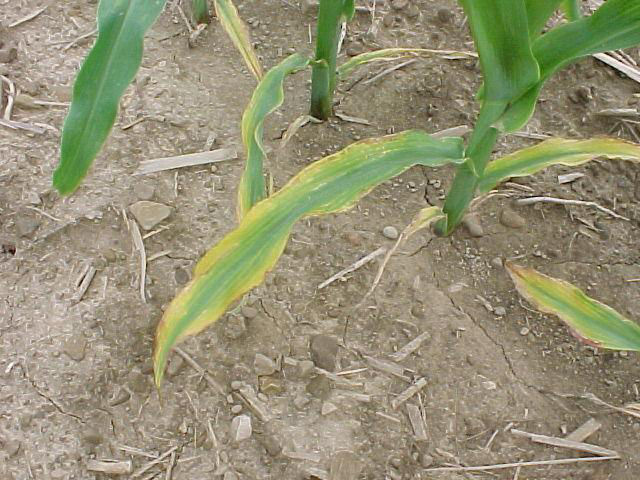Importance of Adequate Potassium for Corn Production
May 2, 2025
Potassium (K) is one of the 17 essential nutrients required for corn to complete its lifecycle. It is considered a primary macronutrient, due to the large quantity needed throughout the growing season. Adequate K in corn production is crucial because if deficient, corn plants can become physiologically unstable and crop yield potential may be reduced (Figure 1).

Function of Potassium in Corn
Potassium is responsible for many functions within a corn plant. Overall, the nutrient’s key role is associated with the movement of water, nutrients, and carbohydrates within plant tissue. One of K’s most well-known functions is regulating stomatal closure, which manages water transpiration as well as the exchange of oxygen and carbon dioxide. Other important functions include enzyme activation, aiding in photosynthesis, enhanced drought tolerance, enhanced plant standability, and reduced impact of disease.1 Most K functions are physiological and as such are difficult to determine until the end of season by using a yield map. However, stalk lodging (Table 1) and disease incidence (Table 2) are in-season observations that are associated with adequate K in corn production.
In Table 1, three of the four years showed improved stalk quality when applying K to corn. This trend matches field observations by Bayer Technical Agronomists, when K is optimal stalk quality is drastically improved. In Table 2, disease incidence is shown to be reduced by 50 to 80% when K fertility is sufficient for host crops. Thus, if corn does not have adequate K, it is likely to have an increased potential for disease pressure.
Table 1. Potassium Fertilizer Effect on Corn Yield and Lodging Potentials*

Table 2. Potassium fertilizer effect on disease incidence*

Fertility Considerations
Overall, K content in soils can exceed 20,000 parts per million (ppm).1 However, 90 to 98% is held within primary minerals and isn’t available for plant uptake.1 These minerals need to mineralize over time to release K. An additional soil K form is referred to as “slowly available K” in which K ions are held between clay layers that is a reservoir for “readily available K”. Readily available K is the K in solution or held on clay exchange sites that is available for plant uptake. This relatively small pool is important to manage as it is the form corn uptakes throughout the growing season. Soil testing is an excellent way to determine how much K is within your readily available pool. When interpreting a dry soil test, Iowa State University’s optimum soil K recommendation is between 161 to 200 ppm.5 If within this category, consider crop removal rates to determine adequate K fertilizer. If below this category, consider building up K by applying more fertilizer.5 Common forms of K fertilizer are potassium chloride, potassium thiosulfate, potassium nitrate, and manure.
In summary, if K levels are deficient many functions within a corn plant are impacted, which will in turn reduce crop yield. To ensure adequate K is available for corn production perform regular soil tests. Contact your Channel® brand Technical Agronomist for local recommendations.
Channel Agronomist
Austin Schleich
Sources
1Kaiser, D.E. and Rosen, C.J. (2018). Potassium for crop production. University of Minnesota Extension. https://extension.umn.edu/phosphorus-and-potassium/potassium-crop-production#:~:text=Role%20in%20plant%20growth,regulate%20the%20rate%20of%20photosynthesis.
2Effects of potassium on plant diseases. 1998. Better crops with plant food. International Plant Nutrition Institute. Volume 82(3): 37-39.
3Huber, D.M. and Arny, D.C. (1985). Interactions of potassium with plant disease. In R. D. Munson (Ed.), Potassium in Agriculture (pp. 467 - 488). ASA, CSSA, and SSSA.
4Ortel, C.C., Roberts, T.L., and Rupe, J.C. 2024. A review of the interaction between potassium nutrition and plant disease control. Agrosystems, Geosciences & Environment. https://doi.org/10.1002/agg2.20489
5Mallarino, A.P., Sawyer, J.E., Barnhart, S.K., and Licht, M.A. (2023). A general guide for crop nutrient and limestone recommendations in Iowa. Iowa State University Extension and Outreach. PM 1688. https://store.extension.iastate.edu/Product/A-General-Guide-for-Crop-Nutrient-and-Limestone-Recommendations-in-Iowa
Web sources verified 3/17/25 1110_529801